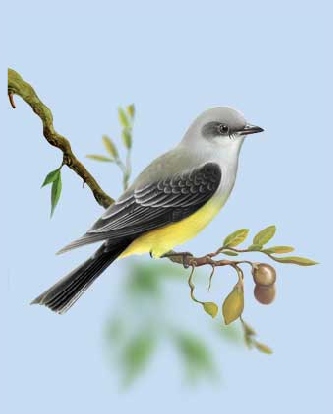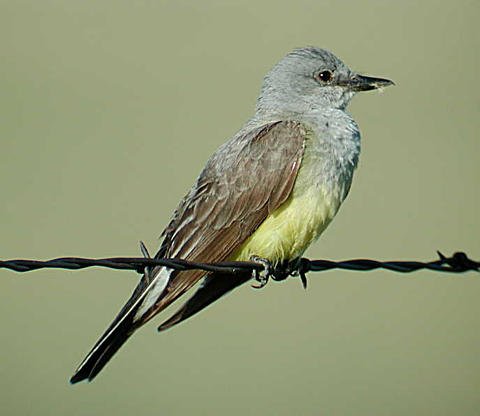
Large flycatcher, gray upperparts,
darker head, white throat and upper breast, and yellow lower breast
and belly. Wings are brown. Tail is black with white edges. Feeds
on insects, fruits and berries. Bouyant fluttering flight on shallow
wing beats. Hovers over prey and dips down.

|
WESTERN
KINGBIRD
Tyrannus verticalis
PASSERIFORMES
Flycatchers (Tyrannidae)
Range and Habitat
Breeds throughout the west, from southern Canada south to Mexico, east
to Great Plains. Regular fall migrant on the
Atlantic coast and winters in the tropics. Preferred habitats include
open country such as ranches, roadsides, streams, and ponds with trees.
SOUND: "ker-er-ip, ker-er-ip, pree pree prpreee",
"kit"
The Western Kingbird has benefited from the cutting of forests. Alfalfa
and livestock pastures provide a plentiful diet of insects.
The male has an impressive courtship display in which he twists and
turns to about 60 feet in the air at which point he stalls, and then
tumbles, flips, and twists as he falls toward the ground.
They catch insects on the wing, often leaving its perch and chasing
flying insects for 40 to 60 feet.
A group of kingbirds are collectively known as a "coronation",
"court", and "tyranny" of kingbirds.
The Western Kingbird is a large tyrant flycatcher which breeds throughout
western North America. The preferred habitat for this bird is open areas
with some low bushes or shrubs. Nests are built in a cup shape and placed
in trees or shrubs, or on high man-made structures.
Diets consist mainly of insects and berries caught in-flight
or on the ground. In winter months, the Western Kingbird migrates to
Florida and the Pacific coastlines of southern
Mexico and Central America. This species is very aggressive in defending
its territory, including against large birds.

|



